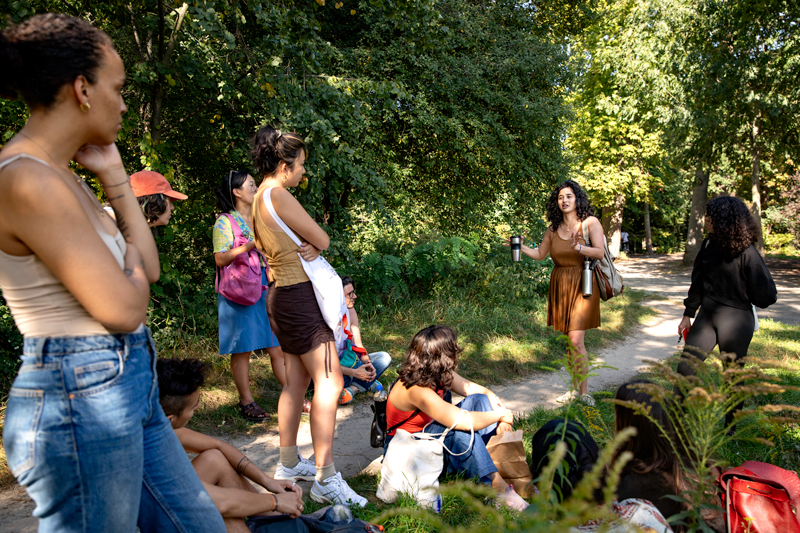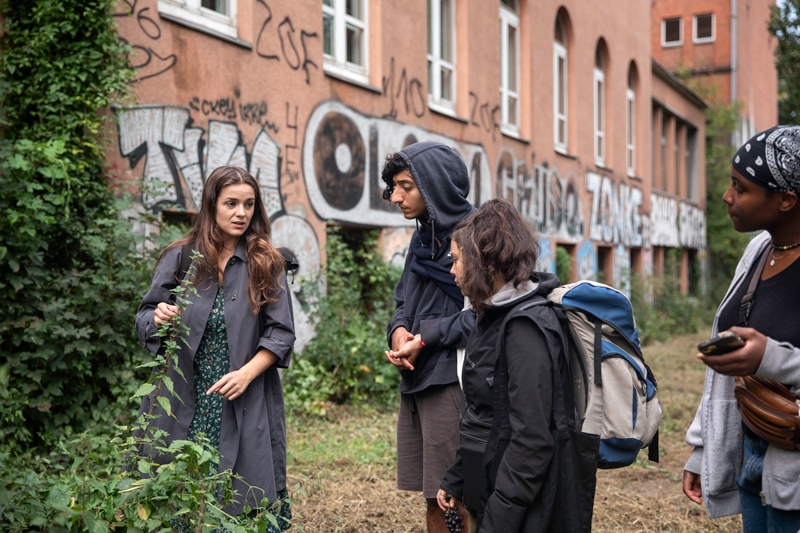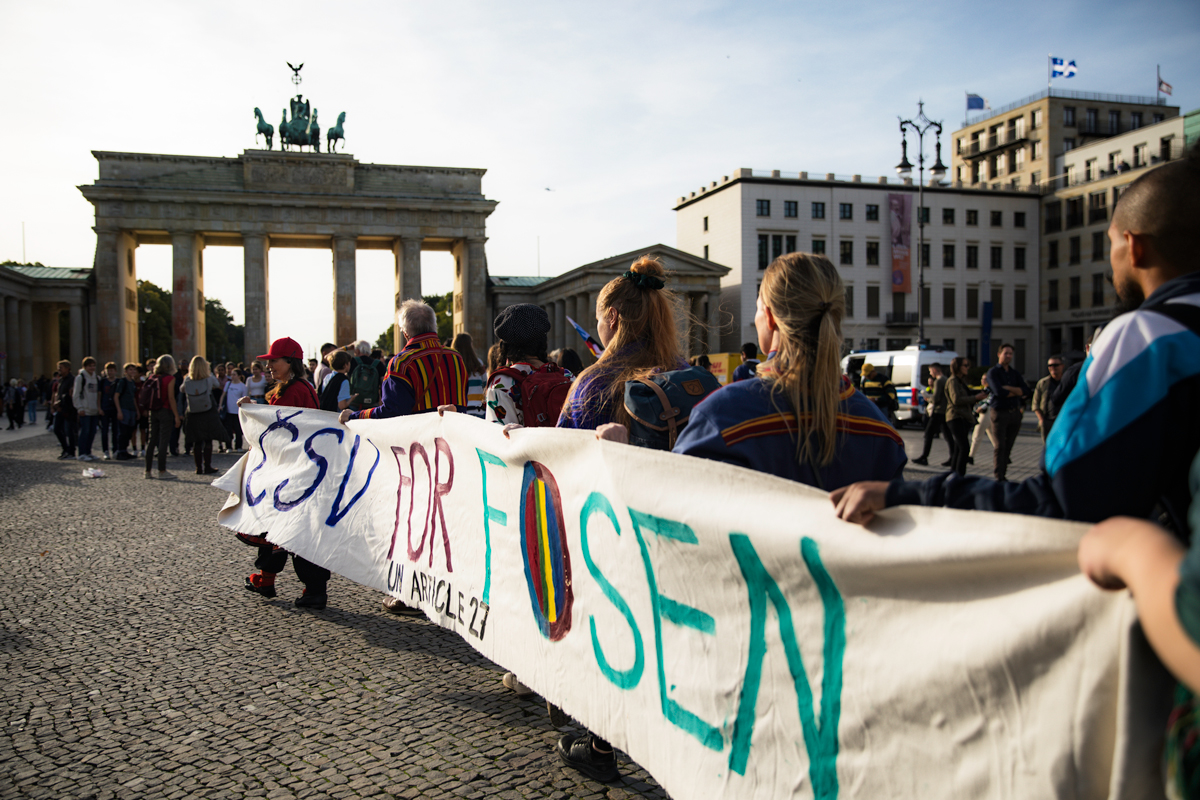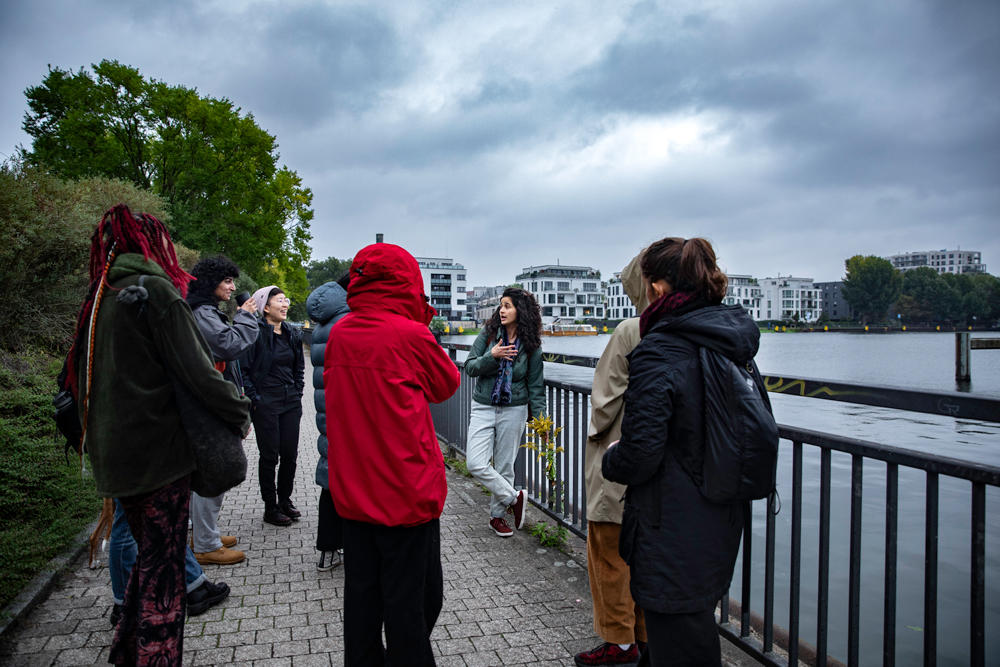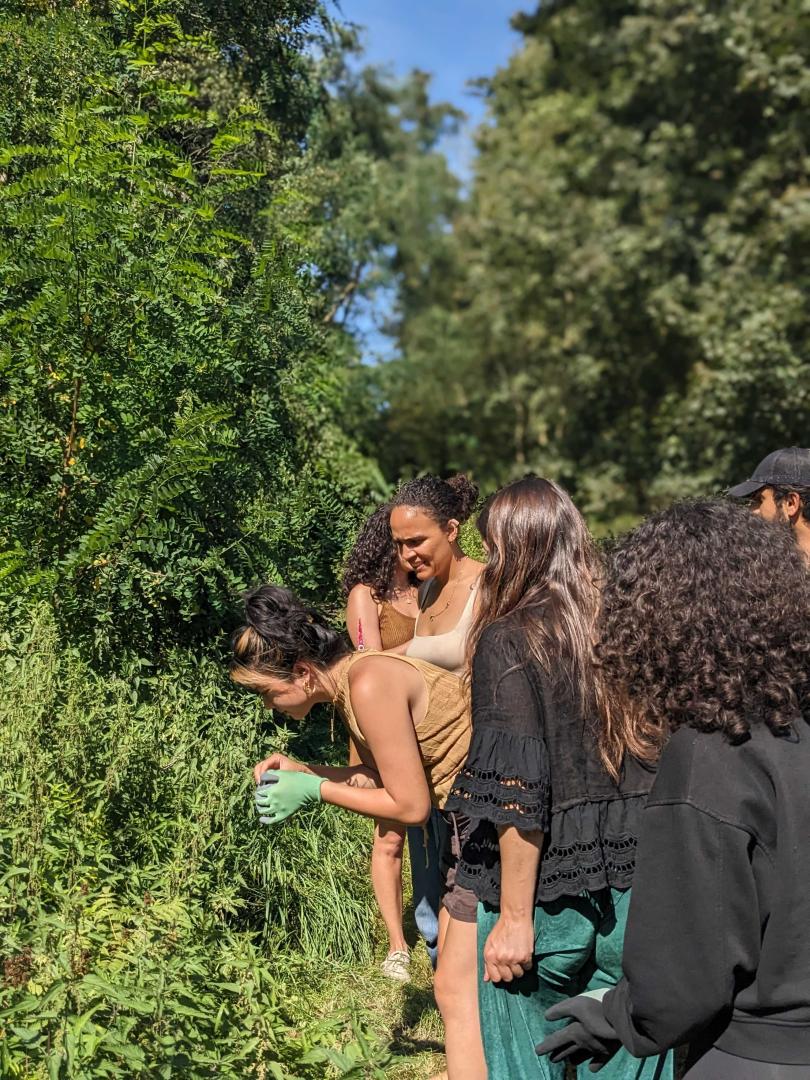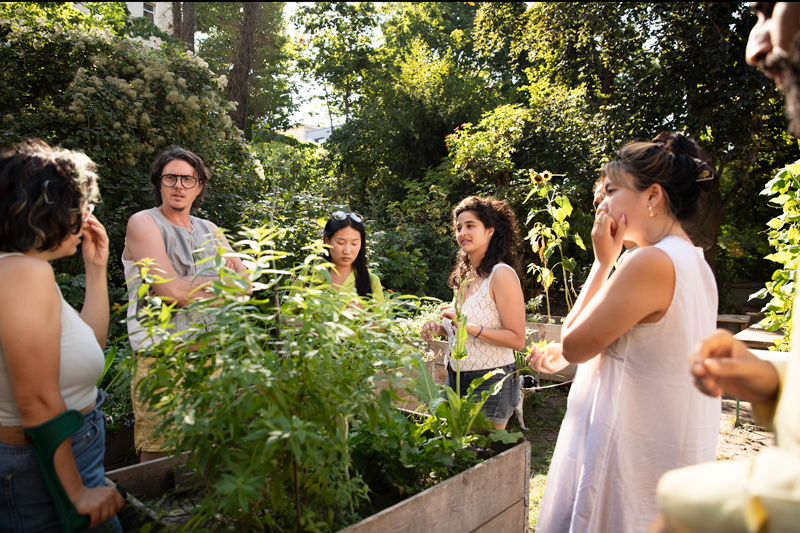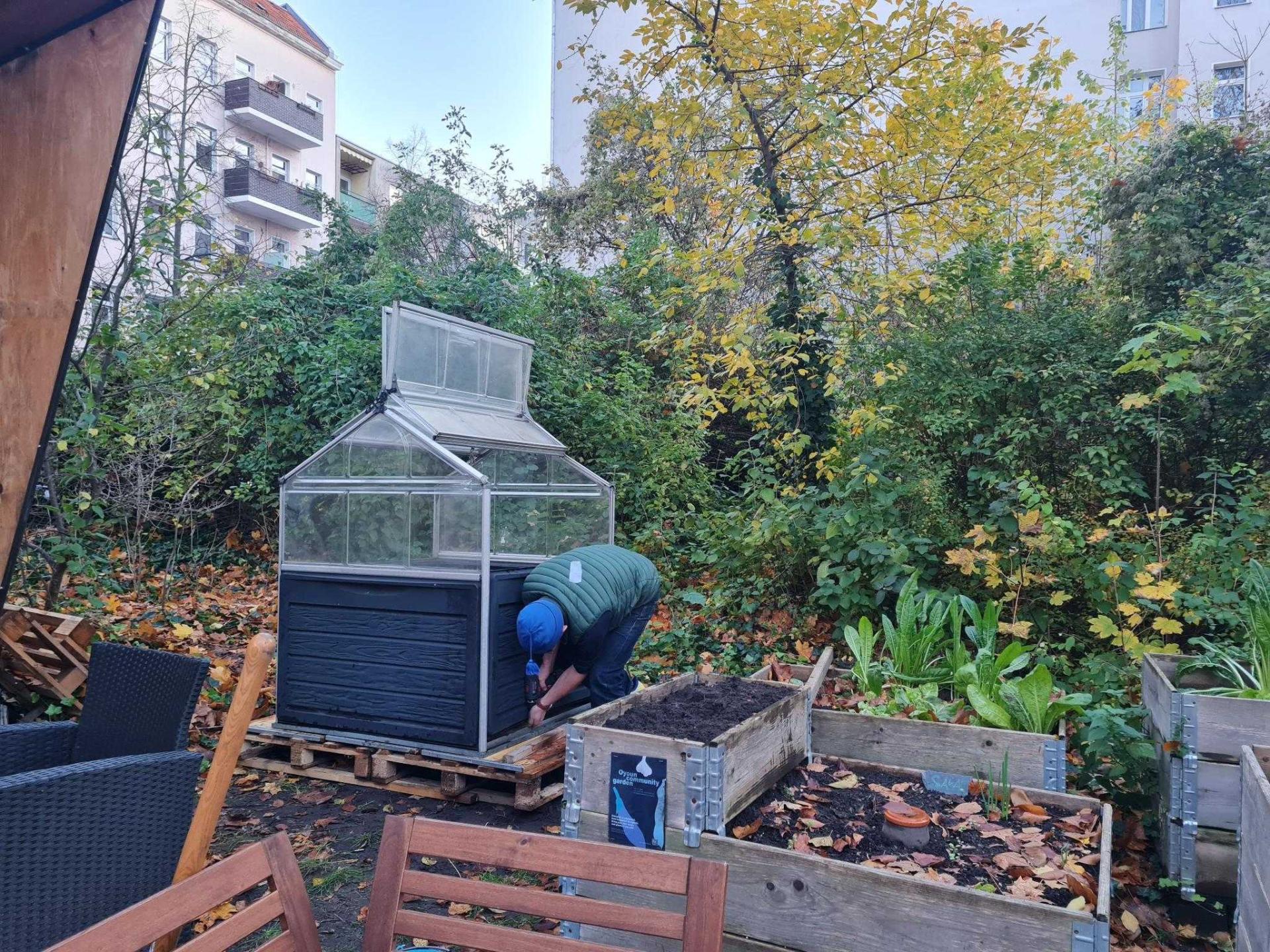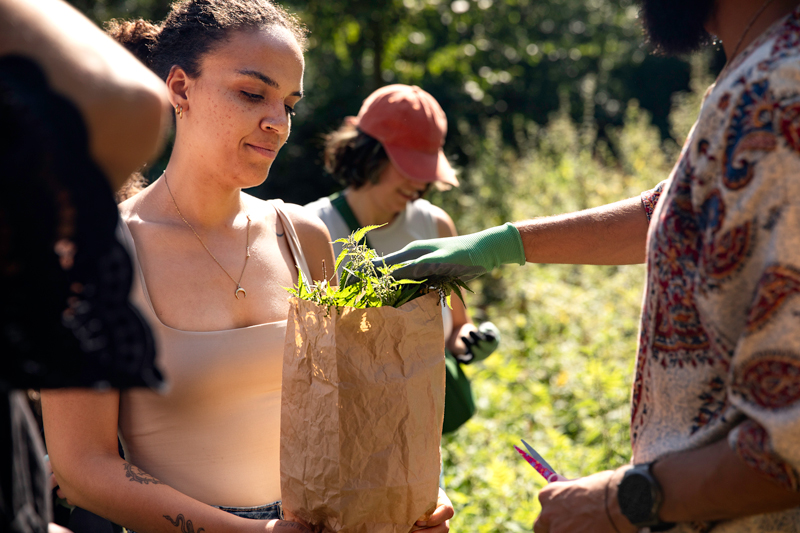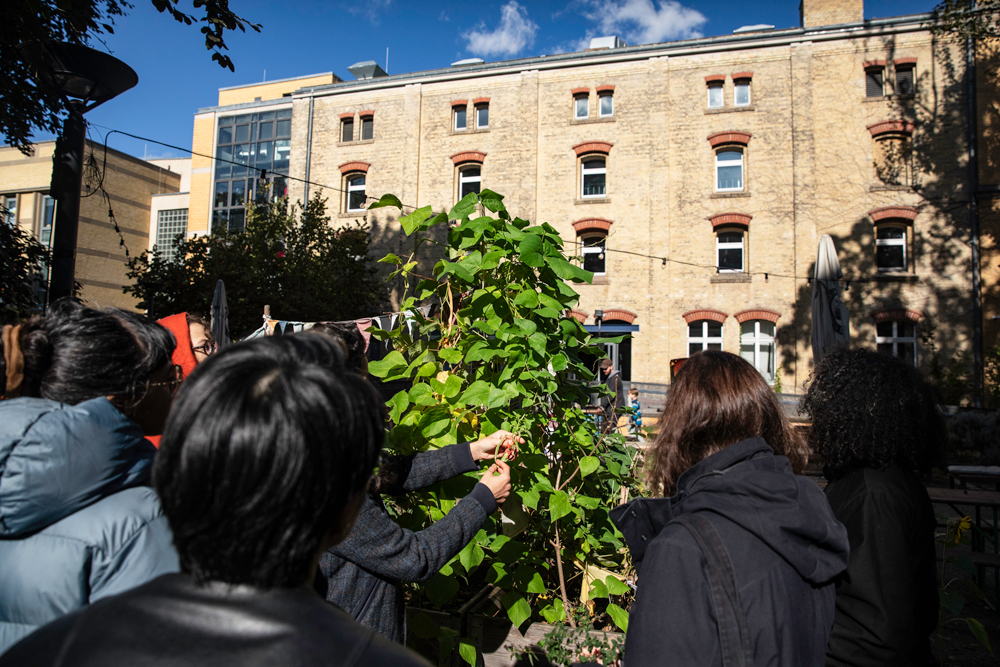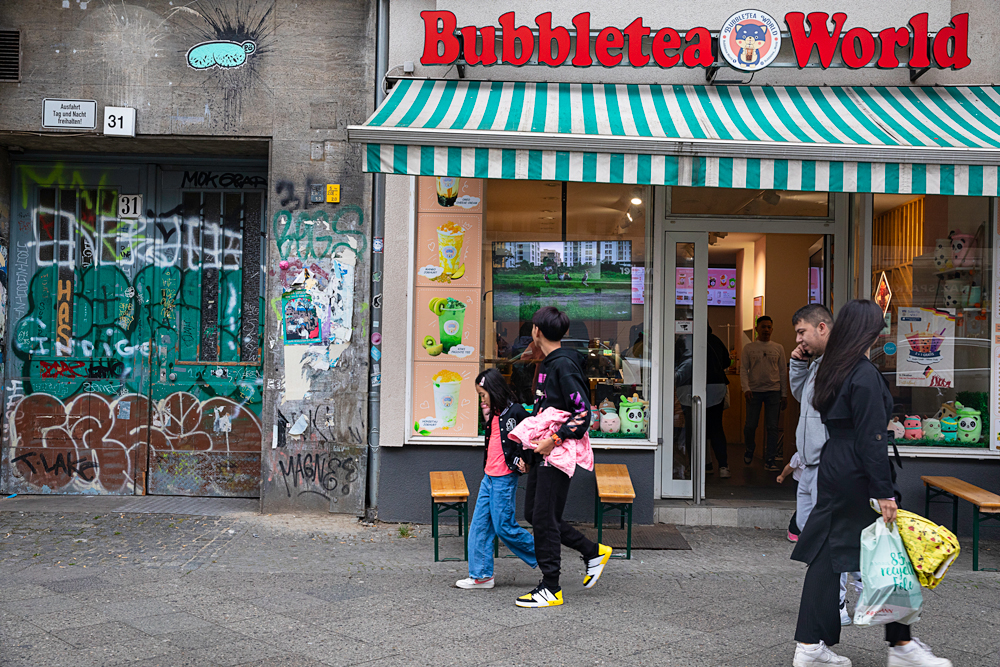Sea Behind The Wall
Basic information
Project Title
Sea Behind The Wall
Full project title
"Sea Behind The Wall" - a project as part of Oyoun's curatorial focus “Listening to the Land”
Category
Reconnecting with nature
Project Description
The project “Sea Behind The Wall” responds to the growing need to imagine regenerative futures centering BIPOC narratives and alternative methodologies against environmental degradation. It is an experiential artistic and educational program that encourages communities to interact with their environment and become more involved by exploring concepts and content through hands-on experiences, interdisciplinary arts and culture, creative and sustainable research, archiving and storytelling.
Geographical Scope
Local
Project Region
Berlin, Germany
Urban or rural issues
It addresses urban-rural linkages
Physical or other transformations
It refers to other types of transformations (soft investment)
EU Programme or fund
No
Description of the project
Summary
How can we imagine regenerative futures which centre BIPOC narratives and alternative methodologies? In what ways can decolonial perspectives and regenerative strategies be infused into artistic interventions, leaving a lasting imprint on social discourse?
With the project “Sea Behind the Wall” Oyoun aims for a future past a neocolonial and heteropatriarchal status quo, in which indigenous knowledge systems are shaping climate policies through a critical and ethical use of technology and design as well as inclusive democratic decision-making processes. The project imagines a radical transformation of our relation to nature by presenting a future of holistic sustainability, self-determination and justice. It also develops strategies through art and culture to build a morally responsible and resilient society equipped to transform according to future needs.
The project works against (post-)colonial, capitalist and patriarchal power dynamics and is anti-hierarchical both internally and externally.
Black, Indigenous and People of Colour (BIPOC) have been at the forefront of justice movements that seek to unsettle hegemonies and are dedicated to political goals of liberation. Our shared histories are knitted together with complex, interwoven patterns across geographies, which are difficult to unravel today. In these spaces we find alternative reimaginations and an endeavour towards reindigenisation.
The project increases and further develops the visibility of knowledge and practices of diasporic and indigenous people in the public sphere. Furthermore it fosters community networking and transnational solidarity through decolonial and environmentally friendly practice.
Achieved outcomes in the context of the respective category (Reconnecting with nature) we are applying for were the establishment of a vibrant community garden, a strengthening of the Human-Plant Connection as well as the consolidation of Environmental Awareness in urban areas.
With the project “Sea Behind the Wall” Oyoun aims for a future past a neocolonial and heteropatriarchal status quo, in which indigenous knowledge systems are shaping climate policies through a critical and ethical use of technology and design as well as inclusive democratic decision-making processes. The project imagines a radical transformation of our relation to nature by presenting a future of holistic sustainability, self-determination and justice. It also develops strategies through art and culture to build a morally responsible and resilient society equipped to transform according to future needs.
The project works against (post-)colonial, capitalist and patriarchal power dynamics and is anti-hierarchical both internally and externally.
Black, Indigenous and People of Colour (BIPOC) have been at the forefront of justice movements that seek to unsettle hegemonies and are dedicated to political goals of liberation. Our shared histories are knitted together with complex, interwoven patterns across geographies, which are difficult to unravel today. In these spaces we find alternative reimaginations and an endeavour towards reindigenisation.
The project increases and further develops the visibility of knowledge and practices of diasporic and indigenous people in the public sphere. Furthermore it fosters community networking and transnational solidarity through decolonial and environmentally friendly practice.
Achieved outcomes in the context of the respective category (Reconnecting with nature) we are applying for were the establishment of a vibrant community garden, a strengthening of the Human-Plant Connection as well as the consolidation of Environmental Awareness in urban areas.
Key objectives for sustainability
Sustainability encompasses more than material actions; it extends to how we lead our lives, challenging ingrained prejudices and preconceived notions to unlock our potential. True sustainability transforms daily practices, fostering a better future and highlighting unheard voices.
The commitment to sustainability includes amplifying marginalized voices, addressing their lack of essential resources. This aims to bridge the gap, creating inclusivity not only in the environment but also in human experiences.
The SBTW project aligns with Economic Resilience, building regenerative economic systems through project activities, sustainable agriculture, and artistic formats. Key sustainability objectives include:
1 - Fostering a collective imagination through workshops, film screenings, and exhibitions as sustainable educational tools.
2 - Establishing an inclusive Community Garden, especially for BIPOC communities at Oyoun, promoting local food production and addressing social equity in green spaces.
3 - Educating on seed sovereignty, emphasising individuals' right to control their seed source, aligning with regenerative agriculture principles.
4 - Integrating the regenerative role of land into practice, translating research into real-world impact through workshops on agroecology, sustainable design, and foraging.
5 - Workshops like "Agri/Cultural Practices for Climate Justice" focus on foraging, guerrilla gardening, and sustainable design, incorporating Indigenous knowledge. These hands-on experiences encourage alternative, less extractive practices, emphasising the land's regenerative potential.
The commitment to sustainability includes amplifying marginalized voices, addressing their lack of essential resources. This aims to bridge the gap, creating inclusivity not only in the environment but also in human experiences.
The SBTW project aligns with Economic Resilience, building regenerative economic systems through project activities, sustainable agriculture, and artistic formats. Key sustainability objectives include:
1 - Fostering a collective imagination through workshops, film screenings, and exhibitions as sustainable educational tools.
2 - Establishing an inclusive Community Garden, especially for BIPOC communities at Oyoun, promoting local food production and addressing social equity in green spaces.
3 - Educating on seed sovereignty, emphasising individuals' right to control their seed source, aligning with regenerative agriculture principles.
4 - Integrating the regenerative role of land into practice, translating research into real-world impact through workshops on agroecology, sustainable design, and foraging.
5 - Workshops like "Agri/Cultural Practices for Climate Justice" focus on foraging, guerrilla gardening, and sustainable design, incorporating Indigenous knowledge. These hands-on experiences encourage alternative, less extractive practices, emphasising the land's regenerative potential.
Key objectives for aesthetics and quality
“Sea Behind The Wall” fosters the collective imagination and challenges dominant narratives through various artistic (sub-)projects. Therefore three main objectives had been set and multiple achievements have met:
1 - Encourage artistic practices that explore ecological and climate justice issues. The project has curated diverse artistic expressions, including art installations, film screenings, performances, exhibitions, and interventions, providing a platform for artists to engage with environmental themes creatively. The use of various mediums contributes to a rich aesthetic experience including traditional performances, contemporary dance, and poetry. This diversity of expression contributes to a more inclusive and engaging cultural experience that prompt reflection on ecological challenges, climate justice, and the relationships between humans and the environment.
2- Collective Redesigning of Oyoun’s Community Garden. The Community Garden members grew to an amount of approximately thirty people consisting of landscape architects, artists, academics, students, engineers, journalists and writers. Together they developed a new design of Oyoun’s Community Garden. Their first implementation was a new greenhouse.
3 - Neighbourhood Engagement and Awareness through multiple street interventions. Those, such as the display of "Species, Soil and Successors" and the performance intervention ‘‘Electric Lies’, actively engage with the community, sparking curiosity and dialogue about environmental issues. This approach aims to create a sense of connection and shared awareness within the neighbourhood. The outdoor video exhibition "Species, Soil and Successors" weaves together Berlin's various neighbourhoods, each with its unique living conditions. By placing videos in these diverse locations, the project creates an imaginative bridge between seemingly unrelated events, enhancing the viewer's experience.
1 - Encourage artistic practices that explore ecological and climate justice issues. The project has curated diverse artistic expressions, including art installations, film screenings, performances, exhibitions, and interventions, providing a platform for artists to engage with environmental themes creatively. The use of various mediums contributes to a rich aesthetic experience including traditional performances, contemporary dance, and poetry. This diversity of expression contributes to a more inclusive and engaging cultural experience that prompt reflection on ecological challenges, climate justice, and the relationships between humans and the environment.
2- Collective Redesigning of Oyoun’s Community Garden. The Community Garden members grew to an amount of approximately thirty people consisting of landscape architects, artists, academics, students, engineers, journalists and writers. Together they developed a new design of Oyoun’s Community Garden. Their first implementation was a new greenhouse.
3 - Neighbourhood Engagement and Awareness through multiple street interventions. Those, such as the display of "Species, Soil and Successors" and the performance intervention ‘‘Electric Lies’, actively engage with the community, sparking curiosity and dialogue about environmental issues. This approach aims to create a sense of connection and shared awareness within the neighbourhood. The outdoor video exhibition "Species, Soil and Successors" weaves together Berlin's various neighbourhoods, each with its unique living conditions. By placing videos in these diverse locations, the project creates an imaginative bridge between seemingly unrelated events, enhancing the viewer's experience.
Key objectives for inclusion
The project prioritises accessibility through workshops in public spaces like Oyoun Garden, ensuring affordable cultural experiences for a wider demographic. Partnerships with local organisations, expand access to adjacent neighbourhoods, with the majority of workshop spots reserved for QT*BIPOC, emphasising inclusivity.
Involving diverse professionals and perspectives from Europe, South Asia, Martinique, Zambia, Syria, and Brazil, the project adopts a collaborative, multidisciplinary approach.
Street interventions, outdoor exhibitions, and community workshops actively engage the public, fostering inclusivity and a sense of ownership. Emphasising community gardens and street displays expands accessibility beyond traditional art spaces, reaching a broader audience.
In terms of inclusion, the project focuses on three pillars:
1- Engagement with Local Communities: Research is connected to lived experiences, enriching academic perspectives with grassroots insights. Community gardens and regenerative practices contribute to a long-term impact on local communities, serving as a model for lasting positive change.
2- Participatory and Community-Centric Approach: Actively involving participants, collaborators, and community members in decision-making ensures the project is shaped by the communities it serves.
3 - Inclusion of Indigenous Voices: Actively seeking and including Indigenous voices, as seen in initiatives like the performance intervention ČSV, educates audiences about the socio-political situation in Sápmi. Film screenings curated by Mai El-Gammal and Savannah Garcia provide diverse perspectives on post-colonialism, labour, and environmental challenges. Indigenous storytelling practices bring awareness through performative expressions of ecological narratives.
The project's exploration of intersectional climate justice, environmental racism, and colonial legacies reflects an understanding of the interconnected nature of social and environmental issues.
Involving diverse professionals and perspectives from Europe, South Asia, Martinique, Zambia, Syria, and Brazil, the project adopts a collaborative, multidisciplinary approach.
Street interventions, outdoor exhibitions, and community workshops actively engage the public, fostering inclusivity and a sense of ownership. Emphasising community gardens and street displays expands accessibility beyond traditional art spaces, reaching a broader audience.
In terms of inclusion, the project focuses on three pillars:
1- Engagement with Local Communities: Research is connected to lived experiences, enriching academic perspectives with grassroots insights. Community gardens and regenerative practices contribute to a long-term impact on local communities, serving as a model for lasting positive change.
2- Participatory and Community-Centric Approach: Actively involving participants, collaborators, and community members in decision-making ensures the project is shaped by the communities it serves.
3 - Inclusion of Indigenous Voices: Actively seeking and including Indigenous voices, as seen in initiatives like the performance intervention ČSV, educates audiences about the socio-political situation in Sápmi. Film screenings curated by Mai El-Gammal and Savannah Garcia provide diverse perspectives on post-colonialism, labour, and environmental challenges. Indigenous storytelling practices bring awareness through performative expressions of ecological narratives.
The project's exploration of intersectional climate justice, environmental racism, and colonial legacies reflects an understanding of the interconnected nature of social and environmental issues.
Results in relation to category
The project has achieved significant results and impacts in various dimensions:
1 - Ecological Impacts / Long-Term Sustainability
The Oyoun community garden stands as an educational space for sustainable agriculture, focusing on agroecology and permaculture. Beyond its ecological role, it serves as a social hub fostering community engagement and inclusivity. This emphasis on cultural exchange and ecological knowledge transmission. BIPOC communities take ownership, aligning the space with their cultural identity and commitment to sustainability.
2- Human-Plant Connection and Environmental Awareness
The project's emphasis on interconnectedness deepens the connection between humans and the environment, creating awareness about environmental challenges and encouraging sustainable urban living practices.
3- Cultural Significance of Plants
Exploring the cultural significance of specific plant species adds a layer of depth to the human-plant connection, highlighting their importance in local traditions, rituals, and medicinal practices. This cultural lens fosters an appreciation for preserving biodiversity and underscores the unique roles plants play in different societies.
4- Direct Beneficiaries
Participants in agroecology workshops, foraging sessions, and street interventions directly benefit, fostering a heightened connection to nature. Artists, cultural practitioners, and the audience directly benefit from film screenings, performances, and exhibitions. BIPOC Communities..
5 - Indirect Beneficiaries
Street interventions and public displays have a broader impact on neighbourhoods, sparking interest and discussions among residents exposed to the project's themes. Policy discussions and advocacy efforts, providing valuable insights for policymakers and environmental advocates.
6 - Collaboration and Partnerships
The project's collaborations with local authorities, environmental organisations, and stakeholders.
1 - Ecological Impacts / Long-Term Sustainability
The Oyoun community garden stands as an educational space for sustainable agriculture, focusing on agroecology and permaculture. Beyond its ecological role, it serves as a social hub fostering community engagement and inclusivity. This emphasis on cultural exchange and ecological knowledge transmission. BIPOC communities take ownership, aligning the space with their cultural identity and commitment to sustainability.
2- Human-Plant Connection and Environmental Awareness
The project's emphasis on interconnectedness deepens the connection between humans and the environment, creating awareness about environmental challenges and encouraging sustainable urban living practices.
3- Cultural Significance of Plants
Exploring the cultural significance of specific plant species adds a layer of depth to the human-plant connection, highlighting their importance in local traditions, rituals, and medicinal practices. This cultural lens fosters an appreciation for preserving biodiversity and underscores the unique roles plants play in different societies.
4- Direct Beneficiaries
Participants in agroecology workshops, foraging sessions, and street interventions directly benefit, fostering a heightened connection to nature. Artists, cultural practitioners, and the audience directly benefit from film screenings, performances, and exhibitions. BIPOC Communities..
5 - Indirect Beneficiaries
Street interventions and public displays have a broader impact on neighbourhoods, sparking interest and discussions among residents exposed to the project's themes. Policy discussions and advocacy efforts, providing valuable insights for policymakers and environmental advocates.
6 - Collaboration and Partnerships
The project's collaborations with local authorities, environmental organisations, and stakeholders.
How Citizens benefit
The project “Sea Behind The Wall” incorporates a citizen science approach, leveraging the collective power of community members to contribute to scientific research and environmental understanding.
1- Hands-on Practitioners
With workshops on "Agri/Cultural Practices for Climate Justice" principles of agroecology and sustainable landscape design were bridged to multiple participants, including citizens from diverse backgrounds and neighbourhoods, engaging in hands-on activities. Citizens actively participate in ecological practices, contributing to a grassroots level of knowledge and creation. This involvement fosters a sense of empowerment and encourages participants to become practitioners of sustainable agriculture.
Workshops like “Harvesting Resilience” were focused on foraging and guerilla gardening as part of a long-term research project. Participants, including citizens, collaborate in mapping foraging paths and sharing intergenerational and intercultural knowledge related to the plant world.
2- Community Empowerment
Also the revitalised community garden of Oyoun is a long lasting magnet for citizens with diverse migrant backgrounds and a mirror of a pluralistic society. Participants continue gathering as part of community development and knowledge sharing through hands-on experiences. This engagement strengthens the connection between diasporic communities and their local environments.
3 -Public interventions
Several outdoor video exhibitions across the city of Berlin explore socioeconomic, historical, and cultural contexts in various neighbourhoods. Citizens become observers and contributors by interacting with the content and engaging in a discussion.
This engagement with public spaces and neighbourhoods transformed the role of passive viewers into active participants in the(ir) local narrative. Though “Sea Behind The Wall” encourages citizens to reflect on their surroundings and the global implications of environmental challenges.
1- Hands-on Practitioners
With workshops on "Agri/Cultural Practices for Climate Justice" principles of agroecology and sustainable landscape design were bridged to multiple participants, including citizens from diverse backgrounds and neighbourhoods, engaging in hands-on activities. Citizens actively participate in ecological practices, contributing to a grassroots level of knowledge and creation. This involvement fosters a sense of empowerment and encourages participants to become practitioners of sustainable agriculture.
Workshops like “Harvesting Resilience” were focused on foraging and guerilla gardening as part of a long-term research project. Participants, including citizens, collaborate in mapping foraging paths and sharing intergenerational and intercultural knowledge related to the plant world.
2- Community Empowerment
Also the revitalised community garden of Oyoun is a long lasting magnet for citizens with diverse migrant backgrounds and a mirror of a pluralistic society. Participants continue gathering as part of community development and knowledge sharing through hands-on experiences. This engagement strengthens the connection between diasporic communities and their local environments.
3 -Public interventions
Several outdoor video exhibitions across the city of Berlin explore socioeconomic, historical, and cultural contexts in various neighbourhoods. Citizens become observers and contributors by interacting with the content and engaging in a discussion.
This engagement with public spaces and neighbourhoods transformed the role of passive viewers into active participants in the(ir) local narrative. Though “Sea Behind The Wall” encourages citizens to reflect on their surroundings and the global implications of environmental challenges.
Physical or other transformations
It refers to other types of transformations (soft investment)
Innovative character
"Sea Behind The Wall" stands out for its innovative character, setting it apart from mainstream actions in the field of climate justice and environmental initiatives following various approaches which are led by justice, community, inclusion, alternative learning, participation and decoloniality.
- Intersectional Climate Justice Approach -
Unlike many mainstream initiatives that focus solely on ecological aspects, the project recognises the importance of addressing the interconnected and overlapping systems of oppression, acknowledging that environmental issues are inseparable from social, economic, and cultural inequalities. It considers the diverse identities and experiences of marginalised individuals and groups makes the unique challenges faced by those to foster a more comprehensive response to environmental issues.
- Listening and Imagination as Methodologies -
The project introduces a reflective and imaginative dimension, encouraging a deeper understanding of complex issues. It challenges the conventional problem-solving attitude by fostering a collective imagination that recognizes interconnectedness.
- Inclusive Artistic Practices -
While mainstream projects may use conventional communication methods, "Sea Behind The Wall" creatively intertwines art, culture, and activism, providing a unique and accessible entry point for diverse audiences while following an anti- and transdisciplinary approach.
- Leveraging Indigenous and Local Knowledge -
The project's engagement with indigenous and local communities, brings forth the value of traditional knowledge in addressing contemporary environmental challenges. Mainstream actions often overlook or sideline indigenous perspectives, whereas this project actively seeks and integrates them, acknowledging the wisdom embedded in local practices.
- Citizen Science Approach -
Involving citizens in scientific processes enhances community engagement and contributes valuable data.
- Intersectional Climate Justice Approach -
Unlike many mainstream initiatives that focus solely on ecological aspects, the project recognises the importance of addressing the interconnected and overlapping systems of oppression, acknowledging that environmental issues are inseparable from social, economic, and cultural inequalities. It considers the diverse identities and experiences of marginalised individuals and groups makes the unique challenges faced by those to foster a more comprehensive response to environmental issues.
- Listening and Imagination as Methodologies -
The project introduces a reflective and imaginative dimension, encouraging a deeper understanding of complex issues. It challenges the conventional problem-solving attitude by fostering a collective imagination that recognizes interconnectedness.
- Inclusive Artistic Practices -
While mainstream projects may use conventional communication methods, "Sea Behind The Wall" creatively intertwines art, culture, and activism, providing a unique and accessible entry point for diverse audiences while following an anti- and transdisciplinary approach.
- Leveraging Indigenous and Local Knowledge -
The project's engagement with indigenous and local communities, brings forth the value of traditional knowledge in addressing contemporary environmental challenges. Mainstream actions often overlook or sideline indigenous perspectives, whereas this project actively seeks and integrates them, acknowledging the wisdom embedded in local practices.
- Citizen Science Approach -
Involving citizens in scientific processes enhances community engagement and contributes valuable data.
Disciplines/knowledge reflected
The project “Sea Behind The Wall” as part of Oyouns curatorial focus “Listening to the Land” is a multidisciplinary exploration of intersectional climate justice, involving various disciplines and knowledge fields in its design and implementation. It thrives on the interaction between disciplines of art, science, academia and technology as it came together through interactive installations, performance, films, agriculture, theatre, and visual arts. This collaborative, multidisciplinary approach adds significant value by offering diverse perspectives, fostering collective imagination, and addressing complex issues related to climate justice and the environment.
Methodology used
The multidimensional and interdisciplinary approach of “Sea Behind The Wall”, blending artistic expression, cultural exploration, and research methodologies, participatory and community centric framework while engaging artists, researchers, activists, and community members from diverse backgrounds, fostering collaboration across disciplines. This approach ensures a multifaceted exploration of climate justice, environmental issues, and cultural narratives.
The project adopted a practice-oriented approach to inquiry, emphasising experiential learning and embodied knowledge through workshops, public interventions, and community gatherings.
-Alternative Learning Formats
Traditional environmental education often relies on formal settings. "Sea Behind the Wall" disrupts this norm, making learning interactive, experiential, and engaging for participants. The project employs workshops, outdoor exhibitions, street interventions, and film screenings as educational tools. It recognizes the importance of diverse learning formats beyond traditional lectures and presentations.
-Participatory Action Approach
It involves actively engaging individuals and communities in the processes of decision-making, problem-solving, and creative expression. Ensuring that communities actively contribute to and benefit from the exploration of intersectional climate justice.
It actively involves participants in reshaping their immediate environment, promoting a sense of agency and empowerment.
Taking the narratives to the streets through outdoor exhibitions and street interventions. This approach aims to make art more accessible to the public, fostering discussions and creating connections between diverse neighbourhoods in Berlin.
-Community-Centric Approach
The project emphasises the importance of community involvement for sustainable change through active participation and empowerment at the grassroots level.
The project adopted a practice-oriented approach to inquiry, emphasising experiential learning and embodied knowledge through workshops, public interventions, and community gatherings.
-Alternative Learning Formats
Traditional environmental education often relies on formal settings. "Sea Behind the Wall" disrupts this norm, making learning interactive, experiential, and engaging for participants. The project employs workshops, outdoor exhibitions, street interventions, and film screenings as educational tools. It recognizes the importance of diverse learning formats beyond traditional lectures and presentations.
-Participatory Action Approach
It involves actively engaging individuals and communities in the processes of decision-making, problem-solving, and creative expression. Ensuring that communities actively contribute to and benefit from the exploration of intersectional climate justice.
It actively involves participants in reshaping their immediate environment, promoting a sense of agency and empowerment.
Taking the narratives to the streets through outdoor exhibitions and street interventions. This approach aims to make art more accessible to the public, fostering discussions and creating connections between diverse neighbourhoods in Berlin.
-Community-Centric Approach
The project emphasises the importance of community involvement for sustainable change through active participation and empowerment at the grassroots level.
How stakeholders are engaged
“Sea Behind the Wall” integrates stakeholders on a local, european and international level while focussing on global fights for climate and social justice and their various intersections.
1- Local community & neighbourhoods
On the local level the project connected with different neighbourhoods, especially through the series of outdoor video exhibitions “Species, Soil and Sucessors” which was located in places of daily life like famous Berliner Spätis. Local stakeholders, including community members and residents in neighbourhoods, actively participated in street interventions, workshops, and outdoor exhibitions. Their involvement was crucial in shaping discussions, providing local perspectives, and contributing to the initiative
This local engagement added an outstanding authenticity to the project by incorporating diverse voices from the community. It ensured that the project resonated with the specific concerns and aspirations of the people directly affected by environmental issues.
2 - European Partners
The activities of the project were strongly connected and intervening with European Cultural and Environmental Networks like NKF (Nordic Art Association) and RISK(U) . Cross-boarders collaborations with Sámi community and artists like Camilla Therese Carlsen and her participatory programme “Electric Lies” brought their social political activism and discourse regarding forced displacement from their land in northern Europe, due to state-driven “renewable energy” production, to Berlin.
Those cross-border collaborations shared best practices of decolonial practices and brought indigenous knowledge to the forefront while dealing with the ongoing effects of climate change and power structures. Strategic networking, transnational perspectives while fostering cross-cultural dialogue brought a broader impact to the European but also global relevance of the project and his visibility.
1- Local community & neighbourhoods
On the local level the project connected with different neighbourhoods, especially through the series of outdoor video exhibitions “Species, Soil and Sucessors” which was located in places of daily life like famous Berliner Spätis. Local stakeholders, including community members and residents in neighbourhoods, actively participated in street interventions, workshops, and outdoor exhibitions. Their involvement was crucial in shaping discussions, providing local perspectives, and contributing to the initiative
This local engagement added an outstanding authenticity to the project by incorporating diverse voices from the community. It ensured that the project resonated with the specific concerns and aspirations of the people directly affected by environmental issues.
2 - European Partners
The activities of the project were strongly connected and intervening with European Cultural and Environmental Networks like NKF (Nordic Art Association) and RISK(U) . Cross-boarders collaborations with Sámi community and artists like Camilla Therese Carlsen and her participatory programme “Electric Lies” brought their social political activism and discourse regarding forced displacement from their land in northern Europe, due to state-driven “renewable energy” production, to Berlin.
Those cross-border collaborations shared best practices of decolonial practices and brought indigenous knowledge to the forefront while dealing with the ongoing effects of climate change and power structures. Strategic networking, transnational perspectives while fostering cross-cultural dialogue brought a broader impact to the European but also global relevance of the project and his visibility.
Global challenges
- Dispossession of Indigenous Lands:
Global Challenge: Indigenous communities globally face dispossession and marginalisation.
Local Solution: Engaging in cultural exchange and promoting narratives rooted in Indigenous knowledge contributes to the global discourse on land rights and sovereignty.
- Inadequate Government Representation:
GC: Many communities, especially Indigenous and marginalised groups, lack representation in government decision-making.
LS: Through community engagement, the project empowers local communities to voice concerns, advocating for more inclusive governance structures.
- Deteriorating River Health and Water Scarcity:
GC: Rivers worldwide face degradation due to pollution, industrial activities, and climate change. Water scarcity is a pressing global issue.
LS: The project addresses water-related issues through community-based interventions, contributing to global awareness and advocating for sustainable practices.
- Agrarian Crisis:
GC: Many regions experience agrarian crises with declining agricultural productivity.
LS: Workshops like "Agri/Cultural Practices for Climate Justice" engage with agrarian challenges, promoting sustainable and regenerative agricultural practices.
- Loss of Intergenerational Knowledge:
GC: Globalisation risks eroding traditional knowledge and practices.
LS: The project prioritises knowledge transmission within the local community, fostering a collective imagination that counters the negative impacts of globalisation on intergenerational knowledge transmission.
- Inclusive and Bottom-up Infrastructure/ System:
GC: Systemic limitations often constrain the interplay between migrant backgrounds and their connection to nature.
LS: The project engages people, especially those with migrant backgrounds, in reclaiming their relationship with nature. It reshapes policy-making by involving directly affected communities.
Global Challenge: Indigenous communities globally face dispossession and marginalisation.
Local Solution: Engaging in cultural exchange and promoting narratives rooted in Indigenous knowledge contributes to the global discourse on land rights and sovereignty.
- Inadequate Government Representation:
GC: Many communities, especially Indigenous and marginalised groups, lack representation in government decision-making.
LS: Through community engagement, the project empowers local communities to voice concerns, advocating for more inclusive governance structures.
- Deteriorating River Health and Water Scarcity:
GC: Rivers worldwide face degradation due to pollution, industrial activities, and climate change. Water scarcity is a pressing global issue.
LS: The project addresses water-related issues through community-based interventions, contributing to global awareness and advocating for sustainable practices.
- Agrarian Crisis:
GC: Many regions experience agrarian crises with declining agricultural productivity.
LS: Workshops like "Agri/Cultural Practices for Climate Justice" engage with agrarian challenges, promoting sustainable and regenerative agricultural practices.
- Loss of Intergenerational Knowledge:
GC: Globalisation risks eroding traditional knowledge and practices.
LS: The project prioritises knowledge transmission within the local community, fostering a collective imagination that counters the negative impacts of globalisation on intergenerational knowledge transmission.
- Inclusive and Bottom-up Infrastructure/ System:
GC: Systemic limitations often constrain the interplay between migrant backgrounds and their connection to nature.
LS: The project engages people, especially those with migrant backgrounds, in reclaiming their relationship with nature. It reshapes policy-making by involving directly affected communities.
Learning transferred to other parties
"Sea Behind The Wall" offers a replicable model of interdisciplinary collaboration, bringing together artists, researchers, activists, and community members to address environmental and social challenges holistically. The emphasis on reconnecting with nature, especially for migrant communities, is a transferable concept that contributes to a more inclusive and sustainable urban environment.
Critical engagement and decolonial practices, encouraging critical thinking, fostering dialogue, and amplifying marginalised voices, are strategies applicable globally to address systemic issues. Implementing inclusive governance structures and challenging colonial legacies can be adapted to different social and environmental contexts, offering a stance on acknowledging historical injustices and working towards equitable solutions.
Establishing community gardens and promoting regenerative practices can be adapted to diverse landscapes and communities, fostering community resilience and connection to the land. The workshop model integrating agroecology principles, foraging, and gardening techniques is applicable in different regions, adapting content to local agricultural practices and ecological contexts.
The practice-oriented inquiry approach, emphasising experiential learning and embodied knowledge, can be applied to different topics and settings, providing a dynamic and engaging way to explore complex issues.
Taking art to the streets through outdoor exhibitions and street interventions, democratising art, and facilitating community engagement with important environmental and cultural narratives, can be replicated globally in urban and rural areas.
Strategies used to combat greenwashing, such as street interventions and critical discussions, can be adopted in different contexts. Raising awareness and fostering transparency are transferable elements in the fight against deceptive environmental practices.
Critical engagement and decolonial practices, encouraging critical thinking, fostering dialogue, and amplifying marginalised voices, are strategies applicable globally to address systemic issues. Implementing inclusive governance structures and challenging colonial legacies can be adapted to different social and environmental contexts, offering a stance on acknowledging historical injustices and working towards equitable solutions.
Establishing community gardens and promoting regenerative practices can be adapted to diverse landscapes and communities, fostering community resilience and connection to the land. The workshop model integrating agroecology principles, foraging, and gardening techniques is applicable in different regions, adapting content to local agricultural practices and ecological contexts.
The practice-oriented inquiry approach, emphasising experiential learning and embodied knowledge, can be applied to different topics and settings, providing a dynamic and engaging way to explore complex issues.
Taking art to the streets through outdoor exhibitions and street interventions, democratising art, and facilitating community engagement with important environmental and cultural narratives, can be replicated globally in urban and rural areas.
Strategies used to combat greenwashing, such as street interventions and critical discussions, can be adopted in different contexts. Raising awareness and fostering transparency are transferable elements in the fight against deceptive environmental practices.
Keywords
Justice
Imagination
Climate
Community
Decolonial

